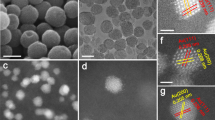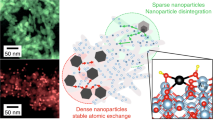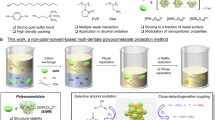Abstract
Supported gold nanoparticles have excited much interest owing to their unusual and somewhat unexpected catalytic properties1,2,3,4,5,6,7, but the origin of the catalytic activity is still not fully understood. Experimental work4 on gold particles supported on a titanium dioxide (110) single-crystal surface has established a striking size threshold effect associated with a metal-to-insulator transition, with gold particles catalytically active only if their diameters fall below ∼3.5 nm. However, the remarkable catalytic behaviour might also in part arise from strong electronic interaction between the gold and the titanium dioxide support2,3,5. In the case of industrially important selective oxidation reactions, explanation of the effectiveness of gold nanoparticle catalysts is complicated by the need for additives to drive the reaction5,7,8, and/or the presence of strong support interactions and incomplete understanding of their possible catalytic role1,2,3,5. Here we show that very small gold entities (∼1.4 nm) derived from 55-atom gold clusters and supported on inert materials are efficient and robust catalysts for the selective oxidation of styrene by dioxygen. We find a sharp size threshold in catalytic activity, in that particles with diameters of ∼2 nm and above are completely inactive. Our observations suggest that catalytic activity arises from the altered electronic structure intrinsic to small gold nanoparticles, and that the use of 55-atom gold clusters may prove a viable route to the synthesis of robust gold catalysts suited to practical application.
This is a preview of subscription content, access via your institution
Access options
Subscribe to this journal
Receive 51 print issues and online access
$199.00 per year
only $3.90 per issue
Buy this article
- Purchase on Springer Link
- Instant access to full article PDF
Prices may be subject to local taxes which are calculated during checkout


Similar content being viewed by others
References
Haruta, M., Kobayashi, T., Sano, H. & Yamada, N. Novel gold catalysts for the oxidation of carbon monoxide at a temperature far below 0°C. Chem. Lett. (Jpn) 16, 405–408 (1987)
Haruta, M. Size- and support-dependency in the catalysis of gold. Catal. Today 36, 153–166 (1997)
Haruta, M. et al. Low-temperature oxidation of CO over gold supported on TiO2, α-Fe2O3, and Co3O4 . J. Catalys. 144, 175–192 (1993)
Valden, M., Lai, X. & Goodman, D. W. Onset of catalytic activity of gold clusters on titania with the appearance of nonmetallic properties. Science 281, 1647–1650 (1998)
Hayashi, T., Tanaka, K. & Haruta, M. Selective vapor-phase epoxidation of propylene over Au/TiO2 catalysts in the presence of oxygen and hydrogen. J. Catalys. 178, 566–575 (1998)
Haruta, M. Catalysis: Gold rush. Nature 437, 1098–1099 (2005)
Hughes, M. D. et al. Tunable gold catalysts for selective hydrocarbon oxidation under mild conditions. Nature 437, 1132–1135 (2005)
Sault, A. G., Madix, R. J. & Campbell, C. T. Adsorption of oxygen and hydrogen on Au(110)-(1x2). Surf. Sci. 169, 347–356 (1986)
Hutchison, J. E. et al. in Inorganic Syntheses Vol. 34 (ed. Shapley, J. R.) 228–232 (Wiley, 2004)
Lu, P. et al. Polymer-protected Ni/Pd bimetallic nano-clusters: preparation, characterization and catalysis for hydrogenation of nitrobenzene. J. Phys. Chem. B 103, 9673–9682 (1999)
Raja, R. et al. Highly efficient catalysts for the hydrogenation of nitro-substituted aromatics. Chem. Commun. 2026–2028 (2005)
López-Quintela, M. A. & Rivas, J. Chemical reactions in microemulsions - a powerful method to obtain ultrafine particles. J. Colloid Interface Sci. 158, 446–451 (1993)
Vaughan, O. P. H. et al. Copper as a selective catalyst for the epoxidation of propene. J. Catalys. 236, 401–404 (2005)
Haruta, M. Gold as a novel catalyst in the 21st century: Preparation, working mechanism and applications. Gold Bull. 37, 27–36 (2004)
Deng, X. Y. & Friend, C. M. Selective oxidation of styrene on an oxygen-covered Au(111). J. Am. Chem. Soc. 127, 17178–17179 (2005)
Lambert, R. M., Williams, F. J., Cropley, R. L. & Palermo, A. Heterogeneous alkene epoxidation: past, present and future. J. Mol. Catalys. A 228, 27–33 (2005)
Chimentao, R. J. et al. Sensitivity of styrene oxidation reaction to the catalyst structure of silver nanoparticles. Appl. Surf. Sci. 252, 793–800 (2005)
Williams, F. J., Bird, D. P. C., Palermo, A., Santra, A. K. & Lambert, R. M. Mechanism, selectivity promotion, and new ultraselective pathways in Ag-catalyzed heterogeneous epoxidation. J. Am. Chem. Soc. 126, 8509–8514 (2004)
Tang, Q. et al. Co2+-exchanged faujasite zeolites as efficient heterogeneous catalysts for epoxidation of styrene with molecular oxygen. Chem. Commun. 440–441 (2004)
Sebastian, J., Jinka, K. M. & Jasra, R. V. Effect of alkali and alkaline earth metal ions on the catalytic epoxidation of styrene with molecular oxygen using cobalt (II)-exchanged zeolite X. J. Catalys. 244, 208–218 (2006)
Boyen, H. G. et al. Oxidation-resistant gold-55 clusters. Science 297, 1533–1536 (2002)
Ono, L. K., Sudfeld, D. & Cuenya, B. R. In situ gas-phase catalytic properties of TiC-supported size-selected gold nanoparticles synthesized by diblock copolymer encapsulation. Surf. Sci. 600, 5041–5050 (2006)
Takahiro, K. et al. Core level and valence band photoemission spectra of Au clusters embedded in carbon. J. Appl. Phys. 100, 084325 (2006)
Wertheim, G. K. & Dicenzo, S. B. Cluster growth and core-electron binding-energies in supported metal clusters. Phys. Rev. B 37, 844–847 (1988)
Santra, A. K. & Goodman, D. W. Oxide-supported metal clusters: models for heterogeneous catalysts. J. Phys. Condens. Matter 15, R31–R62 (2003)
Miller, J. T. et al. The effect of gold particle size on Au–Au bond length and reactivity toward oxygen in supported catalysts. J. Catalys. 240, 222–234 (2006)
Bowker, M., Nuhu, A. & Soares, J. High activity supported gold catalysts by incipient wetness impregnation. Catal. Today 122, 245–247 (2007)
Haruta, M. Catalysis of gold nanoparticles deposited on metal oxides. CATTECH 6, 102–115 (2002)
Briggs, D. & Seah, M. P. (eds) Practical Surface Analysis 2nd edn (Wiley, 1990)
Acknowledgements
M.T. and O.P.H.V. acknowledge financial support from the UK Engineering and Physical Sciences Research Council and King’s College, Cambridge, respectively.
Author information
Authors and Affiliations
Corresponding author
Supplementary information
Supplementary Figures
This file contains Supplementary Figures 1 and 2 with Legends that describe the characterization of the 0.6 wt% Au/SiO2 catalyst prepared using PVP method and the characterization of the 1 wt% Au/C catalyst prepared using the microemulsion method, respectively; Supplementary Table 1 giving a full statistical breakdown of the particle size distributions of all catalysts; Supplementary Figures 3 and 4 with Legends and Supplementary Discussion describing the effect of catalyst thermal treatment; and additional references. (PDF 1878 kb)
Rights and permissions
About this article
Cite this article
Turner, M., Golovko, V., Vaughan, O. et al. Selective oxidation with dioxygen by gold nanoparticle catalysts derived from 55-atom clusters. Nature 454, 981–983 (2008). https://doi.org/10.1038/nature07194
Received:
Accepted:
Issue Date:
DOI: https://doi.org/10.1038/nature07194
This article is cited by
-
Understanding ligand-protected noble metal nanoclusters at work
Nature Reviews Materials (2023)
-
Regulating the electronic structure through charge redistribution in dense single-atom catalysts for enhanced alkene epoxidation
Nature Communications (2023)
-
Critical evaluation of the glucose oxidase-like activity of gold nanoparticles stabilized by different polymers
Nano Research (2023)
-
Polyacrylonitrile/cellulose nanofiber supported gold nanoparticles for liquid-phase aerobic oxidation of benzyl alcohol to benzaldehyde
Cellulose (2023)
-
Oxidation of furfural to bio-based molecules with hydrogen peroxide via modified layered double hydroxides: the effect of gold nanoparticles on the selectivity
Journal of Porous Materials (2023)
Comments
By submitting a comment you agree to abide by our Terms and Community Guidelines. If you find something abusive or that does not comply with our terms or guidelines please flag it as inappropriate.



